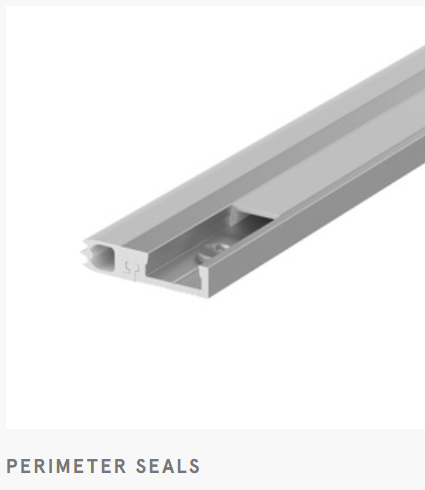-
Posts
505 -
Joined
-
Last visited
Everything posted by Neil Ashdown MAFDI
-

Regulation re fire safe glass in fire doors
Neil Ashdown MAFDI replied to a topic in Fire Doors and Accessories
If the existing glazed door in question is suitable to be used as a fire resisting door, then the existing non-FR glass could most likely be replaced with a fire rated glazing system. But be sure to use, or at least consult, a competent specialist in regard to this work to ensure compliance. -
First image: The smoke seal to the door bottom edge should extend as far as the full width of the door leaf. Ideally the vertical smoke seal would be fitted to the door frame (rather than the door leaf) and therefore would seal the gap you have highlighted. Mastic is unsuitable. Second image: That gap should be 4mm max in accordance with BS 8214: 2016 and the smoke seal fitted to the vertical edge of the door leaf or door frame should seal that gap when the door is closed. Mastic is unsuitable
-
Contact the Door & Hardware Federation for advice https://www.dhfonline.org.uk/
-
"Propose to fit new intumescent strip / smoke seal to an existing d30 fire door, if a gap of 4mm between frame and door is evident on one side of door viewed from inside.Is it necessary to remove door , architrave and increase frame or can you alternatively plant a new lining on the outside frame to increase the rebate to 25mm.( al so still fitting the strip / smoke seals ?) and will this method be Certified as acceptable practice". There appears to be an intumescent strip already fitted and if the door to frame gap is already 4mm, then it complies with BS 8214: 2016. Why not just fit a smoke seal to the push side on rebate stop? Why do you require a 25mm rebate? This is unnecessary. The products you purchase for this task should carry product certification.
-
Looking again at the photo, do you mean the hole or perhaps the gap under the door frame jamb? If so, these may be filled with suitable timber.
-
To comply with the current standard BS 8214: 2016 it would be necessary to reduce the door to frame gap to 4mm maximum and ensure that the threshold seal, when engaged, closes the threshold gap along its length. Mastic would be unsuitable for remediating this defect.
-
In the light of this information, I would suggest you contact the fire door inspector for the details of compliant letter plates. You would then be able to contact the letter plate supplier(s) for evidence of performance, price and availability. Then check compliance again with the fire door inspector before placing any orders.
-
Please post a photograph of the door and defect.
-

Fire door gap from measured from brush or from wood?
Neil Ashdown MAFDI replied to a topic in Fire Doors and Accessories
The max gap at any point, anywhere along and each side of the threshold for fire resistance performance. However, when measuring 3mm for restricted smoke spread the gap at the door bottom edge should be no greater along either side. Refer to BS 8214: 2016 Code of practice - Timber-based fire door assemblies for more information. -
Building Regulations mandate that flat entrance doors must self-close from all door-open positions. The issue with spring hinges is that they often fail to do this completely and reliably. https://assets.publishing.service.gov.uk/media/67d2bb074702aacd2251cb94/Approved_Document_B_volume_1_Dwellings_2019_edition_incorporating_2020_2022_and_2025_amendments_collated_with_2026_and_2029_amendments.pdf This is why guidance at the Code of Practice: Hardware for Fire Doors & Escape Doors requires self-closing devices that meet BS EN 1154 power size 3, as a minimum requirement. https://www.firecode.org.uk/Code_of_Practice_hardware_for_fire_and_escape_doors_issue_5.pdf
-
There are different devices used to provide protection against spread of fire and smoke. Sprinklers and doors are two of them and these devices should be used towards a holistic approach to dealing with fire risk. Clearly, a building with a sprinkler system and fire doors should provide a higher level of protection than a building with fire doors alone. The Responsible Person should carry out a suitable and sufficient fire risk assessment to include the risk to relevant persons at the building and factor in the protection where it is provided by the sprinklers, the fire doors and other devices appropriately. No doubt, using this holistic approach, both sprinklers and fire doors together will form a large part of the fire protections at the building. Both should then be checked and maintained in good condition as appropriate to the fire strategy to provide safety in a fire at the building. It should be clear from the fire risk assessment to what extent the devices provide protection and therefore what is required from the maintenance regime.
-

Old style fire door identification with plugs
Neil Ashdown MAFDI replied to a topic in Fire Doors and Accessories
As far as I am aware, there were no standard scheme markings, such as BM TRADA Q Mark or BWF-Certifire. But the manufacturer may have marked the door for identification purposes. They were called fire-check doors in those days. This may have applied at the time? https://www.scribd.com/document/449684907/BS-476-1-pdf -

Fd30 flat front door frame.
Neil Ashdown MAFDI replied to Rascal's topic in Fire Doors and Accessories
Q) I don't see an easy way to determine the gap and seal between the frame and wall when it's painted and finished? The inspector would just use their judgement? A) Remove the architraves or trims where present. Unless of course the door frame can be seen to be an intimate fit with the wall. -

Fd30 flat front door frame.
Neil Ashdown MAFDI replied to Rascal's topic in Fire Doors and Accessories
Q) What can determine a frame has to be changed? A) Does it meet the specific requirements stated in the certificate of approval / installation instructions for the particular fire door leaf you intend to fit and is the linear gap between the door frame and surrounding wall correctly sized and sealed? -

Fd30 flat front door frame.
Neil Ashdown MAFDI replied to Rascal's topic in Fire Doors and Accessories
So long as you can demonstrate that the fire door assembly you install has all the documentary evidence of product fire and smoke performance and that the installation work can be confirmed as meeting the relevant standards and regulations, it would be reasonable to expect the management company to be satisfied. It may be prudent to consult them before you proceed. Also, trying to fit a new fire door leaf to an existing door frame is challenging due to the usually very limited allowances permitted when trimming the edges of the door. Personally, I would avoid using basic off the shelf fire door leaves for flat entrance doors and would select a higher quality door with good quality hardware and seals for reliable self-closing performance and high security. Replacing a fire door is notifiable works, so I would also consult the Local Building Control office to check what compliance requirements are required to be met. -
It will be necessary to contact the code-lock manufacturer or supplier and examine their specific evidence of fire resistance performance for their product when fitted to a fire door of the type that you intend to use. Generally, that will mean the door must have a solid timber-based core throughout, rather than tubeboard.
-

fire doors with concealed intumescent strip
Neil Ashdown MAFDI replied to a topic in Fire Doors and Accessories
Contact ASDMA to find a supplier or manufacturer https://asdma.com/knowledge-centre/ -
The issue is not so much that the door leaf is not a close fit to the door frame rebate stop. Rather, is the door leaf thickness wholly contained within the door frame rebate or does it stand proud on the 'pull-side'? Some doors have no stated tolerance within their certification document for this issue, others have up to 1mm generally.
-
Consult Building Regulations. In England & Wales its https://www.gov.uk/government/publications/fire-safety-approved-document-b
-

Leading edge to aid closing
Neil Ashdown MAFDI replied to Lee B's topic in Fire Doors and Accessories
Bear in mind the maximum gap should be measured at the point where the intumescent seal is located (eg. double-action doors with rounded meeting edges). Where a fire door manufacturer's technical data fails to address the matter of a 'leading-edge' - consult their technical department. -
So long as the 're-lipping work' is done to a 'joinery' standard (the joint should be difficult to detect) this should be acceptable as a suitable repair.
-

Bespoke veneered internal FD30 fire doors
Neil Ashdown MAFDI replied to a topic in Fire Doors and Accessories
Lever handles are more durable when fitted with back to back fixings through the door, rather than only face fixings. A fire door frame can, in theory, be fixed straight to a suitable wall but in reality packers would likely be necessary for the door to positioned correctly. Hardwood behind the door frame, as a subframe, could be used. A shadow gap is created for aesthetic reasons. Therefore, it would not be filled. -
It depends on the condition of the floor. You could fit a static flexible seal to one face of the door leaf to seal the bottom edge but the seal must not impede the self-closing action of the door.
-
The installer should consult the certification data sheet / technical manual for that particular make and type of door leaf before cutting the aperture and fitting the fire & smoke rated letter plate. Where the relevant document does not permit such a letter plate, then the door manufacturer technical dept should be consulted. Where a letter plate has been fitted to a door where one is not permitted - this would be a 'non-compliance'. It would not become a Nominal Fire Door.


